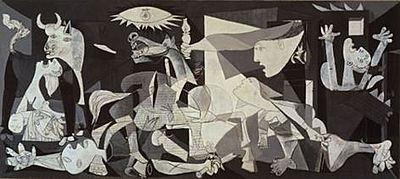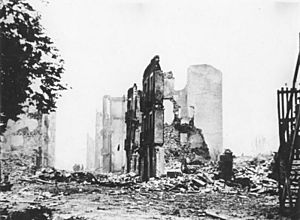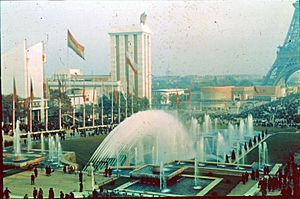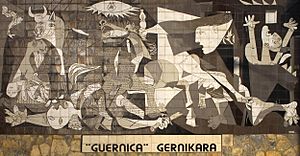Guernica (Picasso) facts for kids
Quick facts for kids Guernica |
|
|---|---|
 |
|
| Artist | Pablo Picasso |
| Year | 1937 |
| Medium | Oil on canvas |
| Movement | Cubism, Surrealism |
| Dimensions | 349.3 cm × 776.6 cm (137.4 in × 305.5 in) |
| Location | Museo Reina Sofía, Madrid, Spain |
Guernica (Spanish: [ɡeɾˈnika]; Basque: [ɡernika]) is a large 1937 oil painting by Spanish artist Pablo Picasso. It is one of his best-known works, regarded by many art critics as the most moving and powerful anti-war painting in history. It is exhibited in the Museo Reina Sofía in Madrid.
The grey, black, and white painting, on a canvas 3.49 meters (11 ft 5 in) tall and 7.76 meters (25 ft 6 in) across, portrays the suffering wrought by violence and chaos. Prominent in the composition are a gored horse, a bull, screaming women, a dead baby, a soldier, and flames.
Picasso painted Guernica at his home in Paris in response to the 26 April 1937 bombing of Guernica, a Basque Country town in northern Spain that was bombed by Nazi Germany and Fascist Italy at the request of the Spanish Nationalists. Upon completion, Guernica was exhibited at the Spanish display at the 1937 Paris International Exposition, and then at other venues around the world. The touring exhibition was used to raise funds for Spanish war relief. The painting soon became famous and widely acclaimed, and it helped bring worldwide attention to the 1936-1939 Spanish Civil War.
Contents
Commission
In January 1937, while Pablo Picasso was living in Paris on Rue des Grands Augustins, he was commissioned by the Spanish Republican government to create a large mural for the Spanish pavilion at the 1937 Paris World's Fair. This piece was to help raise awareness of the war and raise necessary funds. Picasso, who had last visited Spain in 1934 and would never return, was the Honorary Director-in-Exile of the Prado Museum.
Picasso worked somewhat dispassionately from January until late April on the project's initial sketches, which depicted his perennial theme of an artist's studio. Then, immediately upon hearing reports of the 26 April bombing of Guernica, poet Juan Larrea visited Picasso's home to urge him to make the bombing his subject. Days later, on 1 May, Picasso read George Steer's eyewitness account of the attack, which originally had been published in both The Times and The New York Times on 28 April, and abandoned his initial idea. Acting on Larrea's suggestion, Picasso began sketching a series of preliminary drawings for Guernica.
Historical context
Bombing of 26 April 1937
During the Spanish Civil War, the Republican forces were made up of assorted factions such as communists, socialists, anarchists, and others with differing goals. Yet they were united in their opposition to the Nationalists, led by General Francisco Franco, who sought a return to pre-Republican Spain based on law, order, and traditional Catholic values.
Guernica, a town in the province of Biscay in Basque Country, was seen as the northern bastion of the Republican resistance movement and the center of Basque culture. This added to its significance as a target. Around 4:30 p.m. on Monday, 26 April 1937, warplanes of the Nazi Germany Condor Legion, commanded by Colonel Wolfram von Richthofen, bombed Guernica for about two hours. In his journal for 30 April 1937, von Richthofen wrote:
When the first Junkers squadron arrived, there was smoke already everywhere (from the VB [VB/88] which had attacked with 3 aircraft); nobody would identify the targets of roads, bridge, and suburb, and so they just dropped everything right into the center. The 250s toppled a number of houses and destroyed the water mains. The incendiaries now could spread and become effective. The materials of the houses: tile roofs, wooden porches, and half-timbering resulted in complete annihilation. Most inhabitants were away because of a holiday; a majority of the rest left town immediately at the beginning [of the bombardment]. A small number perished in shelters that were hit."
Other accounts state that since it was Guernica's market day, its inhabitants were congregated in the center of town. When the bombardment began they were unable to escape because the roads were full of debris and the bridges leading out of town had been destroyed.
Guernica was a quiet village 10 kilometers from the front lines, and in-between the front lines and Bilbao, the capital of Bizkaia (Biscay). But any Republican retreat towards Bilbao, or any Nationalist advance towards Bilbao, had to pass through Guernica. Wolfram von Richthofen's war diary entry for 26 April 1937 states, "K/88 [the Condor Legion bomber force] was targeted at Guernica in order to halt and disrupt the Red withdrawal which has to pass through here." Under the German concept of tactical bombing, areas that were routes of transportation and troop movement were considered legitimate military targets. The following day, Richthofen wrote in his war diary, "Guernica burning".
The nearest military target of any consequence was a war product factory on Guernica's outskirts, but it went through the attack unscathed. Thus, the attack was widely condemned as a terror bombing.
Guernica's aftermath
Because a majority of Guernica's men were away, fighting on behalf of the Republicans, at the time of the bombing the town was populated mostly by women and children. These demographics are reflected in Guernica.
Picasso lived in Paris during the German occupation during World War II. A widely repeated story is that a German officer once asked him, upon seeing a photo of Guernica in Picasso's apartment, "Did you do that?", and Picasso responded, "No, you did."
Creation
On 11 May the canvas is ready, and immediately the composition is laid down as a linear structure that covers the whole surface. Work on the mural is accompanied by more than thirty studies for the details. The rough plan exists from the beginning, but it takes three weeks before the picture receives its final form. The bull's head remains where it was first put, but the body is turned around to the left. On 20 May the horse lifts its head. The body of the soldier stretched on the floor from left to right changes position on 4 June, then head and hand take on their finished shape.
At the last moment the artist makes one decisive adjustment: the drama first took place on a street with burning houses in the background. Now, suddenly, the diagonals are accentuated, and thereby space becomes ambiguous, unreal, inside and outside at the same time. The lamp is hung over the horse's head, looking on the dreadful scene like a wide-open eye. The construction is strengthened, the mural more strongly integrated within Sert's architecture. Into the hand of the dying soldier, next to the broken sword, Picasso puts the little flower of hope.
The picture was finished about mid-June. Hundreds of thousands of exhibition-goers wandered by, looking on it as a wall decoration, just as Europe wandered by the human drama of the Spanish Civil War—as if it were a matter concerning only the inhabitants of the peninsula. They disregarded the warning, did not understand that democracy on the whole continent was at stake.
Guernica was painted using a matte house paint specially formulated at Picasso's request to have the least possible gloss. American artist John Ferren assisted him in preparing the monumental canvas, and photographer Dora Maar, who had been working with Picasso since mid-1936 photographing his studio and teaching him the technique of cameraless photography, documented its creation. Apart from their documentary and publicity value, Maar's photographs "helped Picasso to eschew color and give the work the black-and-white immediacy of a photograph", according to art historian John Richardson.
Picasso, who rarely allowed strangers into his studio to watch him work, admitted influential visitors to observe his progress on Guernica, believing that the publicity would help the antifascist cause. As his work on the mural progressed, Picasso explained: "The Spanish struggle is the fight of reaction against the people, against freedom. My whole life as an artist has been nothing more than a continuous struggle against reaction and the death of art. How could anybody think for a moment that I could be in agreement with reaction and death? ... In the panel on which I am working, which I shall call Guernica, and in all my recent works of art, I clearly express my abhorrence of the military caste which has sunk Spain in an ocean of pain and death."
Picasso worked on the painting for 35 days, and finished it on 4 June 1937.
Composition
The scene occurs within a room where, on the left, a wide-eyed bull with a tail suggesting rising flame and smoke as seen through a window stands over a grieving woman holding a dead child in her arms. A horse falls in agony in the center of the room, with a large gaping hole in its side, as if it had just been run through by a spear or javelin. The horse appears to be wearing chain mail armor, decorated with vertical tally marks arranged in rows.
A dead soldier lies under the horse. The hand of his right arm grasps a shattered sword, from which a flower grows, and the open palm of his left hand contains a stigma, a symbol of martyrdom derived from the stigmata of Christ. A bare light bulb in the shape of an all-seeing eye blazes over the suffering horse's head.
To the horse's upper right the head and extended right arm of a frightened female figure appears to have floated into the room through a window, and she witnesses the scene. In her right hand she carries a flame-lit lamp, and holds it near the bare bulb. From the right, below the witness, an awe-struck woman staggers towards the center, looking into the blazing light bulb with a blank stare.
Daggers that suggest screaming have replaced the tongues of the horse, the bull, and the grieving woman. To the bull's right a dove appears on a cracked wall through which bright light from the outside shines.
On the far right a fourth woman, her arms raised in terror, her wide open mouth and thrown back head echoing the grieving woman's, is entrapped by fire from above and below. Her right hand suggests the shape of an airplane.
A dark wall with an open door defines the right side of the room.
A "hidden" image formed by the horse appears in Guernica: The horse's nostrils and upper teeth can be seen as a human skull facing left and slightly downward.
Another hidden image is of a bull that appears to gore the horse from underneath. The bull's head is formed mainly by the horse's entire front leg which has the knee on the ground. The leg's knee-cap forms the head's nose. A horn appears within the horse's breast.
Exhibition
1937 Paris International Exhibition
Guernica was unveiled and initially exhibited in July 1937 at the Spanish Pavilion at the Paris International Exposition, where Nazi Germany and the Soviet Union had huge pavilions. The Pavilion, which was financed by the Spanish Republican government at the time of civil war, was built to exhibit the Spanish government's struggle for existence contrary to the Exposition's technology theme. The Pavilion's entrance presented an enormous photographic mural of Republican soldiers accompanied by the slogan:
- We are fighting for the essential unity of Spain.
- We are fighting for the integrity of Spanish soil.
- We are fighting for the independence of our country and for the right of the Spanish people to determine their own destiny.
The display of Guernica was accompanied by a poem by Paul Éluard, and the pavilion displayed The Reaper by Joan Miró and Mercury Fountain by Alexander Calder, both of whom were sympathetic to the Republican cause.
At Guernica's Paris Exhibition unveiling it garnered little attention. The public's reaction to the painting was mixed. Max Aub, one of the officials in charge of the Spanish pavilion, was compelled to defend the work against a group of Spanish officials who objected to the mural's modernist style and sought to replace it with a more traditional painting that was also commissioned for the exhibition, Madrid 1937 (Black Aeroplanes) by Horacio Ferrer de Morgado. Some Marxist groups criticized Picasso's painting as lacking in political commitment, and faulted it for not offering a vision of a better future. In contrast, Morgado's painting was a great success with Spanish Communists and with the public. The art critic Clement Greenberg was also critical of Guernica, and in a later essay he termed the painting "jerky" and "too compressed for its size", and compared it unfavorably to the "magnificently lyrical" The Charnel House (1944–1948), a later antiwar painting by Picasso.
Among the painting's admirers were art critic Jean Cassou and poet José Bergamín, both of whom praised the painting as quintessentially Spanish. Michel Leiris perceived in Guernica a foreshadowing: "On a black and white canvas that depicts ancient tragedy ... Picasso also writes our letter of doom: all that we love is going to be lost..." Jean Cocteau also praised the painting and declared it a cross that "[General] Franco would always carry on his shoulder."
European tour
Guernica, for which Picasso was paid 200,000 francs for his costs by the Spanish Republican government, was one of the few major paintings that Picasso did not sell directly to his exclusive contracted art dealer and friend, Paul Rosenberg. However, after its exhibition Rosenberg organised a four-man extravaganza Scandinavian tour of 118 works by Picasso, Matisse, Braque, and Henri Laurens. The tour's main attraction was Guernica.
From January to April 1938 the tour visited Oslo, Copenhagen, Stockholm, and Göteborg. Starting in late September Guernica was exhibited in London's Whitechapel Art Gallery. This stop was organized by Sir Roland Penrose with Labour Party leader Clement Attlee, and the painting arrived in London on 30 September, the same day the Munich Agreement was signed by the leaders of the United Kingdom, France, Italy, and Germany. It then travelled to Leeds, Liverpool, and, in early 1939, Manchester. There, Manchester Foodship For Spain, a group of artists and activists engaged in sending aid to the people of Spain, exhibited the painting in the HE Nunn & Co Ford automobile showroom for two weeks. Guernica then returned briefly to France.
American tour
After Francisco Franco's victory in Spain, Guernica was sent to the United States to raise funds and support for Spanish refugees. It was first shown at the Valentine Gallery in New York City in May 1939. The San Francisco Museum of Art (later renamed the San Francisco Museum of Modern Art) gave the work its first museum appearance in the United States from 27 August to 19 September 1939. New York's Museum of Modern Art (MoMA) then mounted an exhibition from 15 November until 7 January 1940, entitled: Picasso: 40 Years of His Art. The exhibition, which was organized by MoMA's director Alfred H. Barr in collaboration with the Art Institute of Chicago, contained 344 works, including Guernica and its studies.
At Picasso's request the safekeeping of Guernica was then entrusted to the Museum of Modern Art, and it was his expressed desire that the painting should not be delivered to Spain until liberty and democracy had been established in the country. Between 1939 and 1952, Guernica traveled extensively in the United States. Between 1941 and 1942, it was exhibited at Harvard University's Fogg Museum twice.
Between 1953 and 1956 it was shown in Brazil, then at the first Picasso retrospective in Milan, Italy, and then in numerous other major European cities before returning to MoMA for a retrospective celebrating Picasso's 75th birthday. It then went to Chicago and Philadelphia. By this time, concern for the state of the painting resulted in a decision to keep it in one place: a room on MoMA's third floor, where it was accompanied by several of Picasso's preliminary studies and some of Dora Maar's photographs of the work in progress. The studies and photos were often loaned for other exhibitions, but until 1981, Guernica itself remained at MoMA.
During the Vietnam War, the room containing the painting became the site of occasional anti-war vigils. These were usually peaceful and uneventful, but on 28 February 1974, Tony Shafrazi defaced the painting with red spray paint, painting the words "KILL LIES ALL". The paint was removed with relative ease from the varnished surface.
Establishment in Spain
As early as 1968, Franco had expressed an interest in having Guernica come to Spain. However, Picasso refused to allow this until the Spanish people again enjoyed a republic. He later added other conditions, such as the restoration of "public liberties and democratic institutions". Picasso died in 1973. Franco, ten years Picasso's junior, died two years later, in 1975. After Franco's death, Spain was transformed into a democratic constitutional monarchy, ratified by a new constitution in 1978. However, MoMA was reluctant to give up one of its greatest treasures and argued that a monarchy did not represent the republic that had been stipulated in Picasso's will as a condition for the painting's delivery. Under great pressure from a number of observers, MoMA finally ceded the painting to Spain in 1981. The Spanish historian Javier Tusell was one of the negotiators.
Upon its arrival in Spain in September 1981, it was first displayed behind bomb-and bullet-proof glass screens at the Casón del Buen Retiro in Madrid in time to celebrate the centenary of Picasso's birth, 25 October. The exhibition was visited by almost a million people in the first year. Since that time there has never been any attempted vandalism or other security threat to the painting.
In 1992, the painting was moved from the Museo del Prado to a purpose-built gallery at the Museo Nacional Centro de Arte Reina Sofía, both in Madrid, along with about two dozen preparatory works. This action was controversial in Spain, since Picasso's will stated that the painting should be displayed at the Prado. However, the move was part of a transfer of all of the Prado's collections of art after the early 19th century to other nearby buildings in the city for reasons of space; the Reina Sofía, which houses the capital's national collection of 20th-century art, was the natural place to move it to. At the Reina Sofía, the painting has roughly the same protection as any other work.
Basque nationalists have advocated that the picture should be brought to the Basque Country, especially after the building of the Guggenheim Bilbao Museum. Officials at the Reina Sofía claim that the canvas is now thought to be too fragile to move. Even the staff of the Guggenheim do not see a permanent transfer of the painting as possible, although the Basque government continues to support the possibility of a temporary exhibition in Bilbao.
Tapestry at the United Nations

A full-size tapestry copy of Picasso's Guernica, by Jacqueline de la Baume Dürrbach, hangs at the Headquarters of the United Nations in New York City at the entrance to the Security Council room. It is less monochromatic than the original and uses several shades of brown.
The Guernica tapestry was first displayed from 1985 to 2009, and returned in 2015. Originally commissioned in 1955 by Nelson Rockefeller, since Picasso refused to sell him the original, the tapestry was placed on loan to the United Nations by the Rockefeller estate in 1985.
On 5 February 2003 a large blue curtain was placed to cover over the work at the UN, so that it would not be visible in the background during press conferences by Colin Powell and John Negroponte as they were arguing in favor of war on Iraq. On the following day, UN officials claimed that the curtain was placed there at the request of television news crews, who had complained that the wild lines and screaming figures made for a bad backdrop, and that a horse's hindquarters appeared just above the faces of any speakers. Some diplomats, however, in talks with journalists claimed that the Bush administration pressured UN officials to cover the tapestry, rather than have it in the background while Powell or other US diplomats argued for war on Iraq.
On 17 March 2009, Deputy Spokesperson for the Secretary-General Marie Okabe announced that the Guernica tapestry had been moved to a gallery in London in advance of extensive renovations at UN Headquarters. The Guernica tapestry was the showcase piece for the grand reopening of the Whitechapel Gallery. It was located in the 'Guernica room' which was originally part of the old Whitechapel Library. In 2012 the tapestry was on loan from the Rockefeller family to the San Antonio Museum of Art in San Antonio, Texas. It was returned to the UN by March 2015. Nelson A. Rockefeller Jr., the owner of the tapestry, took it back in February 2021. In February 2022, it was returned to the wall outside the UN Security Council.
Significance and legacy
During the 1970s, Guernica was a symbol for Spaniards of both the end of the Franco regime following Franco's death and of Basque nationalism. The Basque left has repeatedly used imagery from the picture. An example is the organization Etxerat, which uses a reversed image of the lamp as its symbol. Guernica has since become a universal and powerful symbol warning humanity against the suffering and devastation of war. There are no obvious references to the specific attack, making its message universal and timeless.
Art historian and curator W. J. H. B. Sandberg argued in Daedalus in 1960 that Picasso pioneered a “new language” combining expressionistic and cubist techniques in Guernica. Sandberg wrote that Guernica conveyed an “expressionistic message” in its focus on the inhumanity of the air raid, while using "the language of cubism". For Sandberg, the work's defining cubist features included its use of diagonals, which rendered the painting's setting "ambiguous, unreal, inside and outside at the same time". In 2016, the British art critic Jonathan Jones called the painting a "Cubist apocalypse" and stated that Picasso "was trying to show the truth so viscerally and permanently that it could outstare the daily lies of the age of dictators".
Works inspired by Guernica include Faith Ringgold's 1967 painting The American People Series #20: Die; Goshka Macuga's The Nature of the Beast (2009–2010), which used the Whitechapel-hosted United Nations Guernica tapestry; The Keiskamma Guernicas (2010–2017); and Erica Luckert's theatrical production of Guernica (2011–2012). Art and design historian Dr Nicola Ashmore curated an exhibition, Guernica Remakings, at the University of Brighton galleries from 29 July 2017 to 23 August 2017.
See also
- Guernica, 1950 film directed by Alain Resnais and Robert Hessens
- The 2018 television series Genius features Picasso's life and work, including Guernica
- The Weeping Woman, 1937 Picasso painting
- Guernica, 1937 sculpture by René Iché
- The Charnel House, 1944-45 Picasso painting
- Massacre in Korea, 1951 Picasso painting
- Dove, 1949 Picasso lithograph
- 1980 BBC series 100 Great Paintings
- "Guernica", 2023 song by Ian Hunter






